- Home Page
- Asian Kites
- Balinese Kites
Vivid Balinese Kites
From Kids' Toys to HUGE Fish Kites
Bali is kite-mad! Visitors tell of Balinese kites tethered in fields, 15 or 20 at a time. These are mostly flown by children who make their own flying creations from scraps of plastic and bamboo.
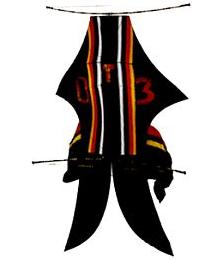 Photo courtesy of Bob Harris
Photo courtesy of Bob HarrisMost of the flying activity in Bali occurs during the dry, windy
months around the middle of the year. Strong easterlies blow at these
times—July in particular—hence the Bali International Kite Festival is
held in that month!
Besides the enthusiasm displayed by the local children, adults also come out in large numbers to fly on special occasions. This is when the huge traditional Balinese kites are flown. See the example in the photo.
Some of these huge bamboo-and-cotton creations require a team of people to tow them up into the prevailing trade winds.
An example is the Bebean or fish kite. Despite having no dihedral, the form of the sail plus the wide ribbon tail on each side are sufficient to keep it stable.
In common with other communities that border the Pacific ocean, like the Maoris in New Zealand, Balinese kiting has very close connections to the local culture and religion. However, a contrast is emerging...
Kites from Bali are becoming known more and more outside the shores of the island and its mother country, Indonesia. Groups of artisans churn out large numbers of beautiful smaller kites, with no two exactly alike. Some end up in overseas travelers' baggage; others are sold over the Internet.
There's a real industry in Balinese kites developing here.
On this site, there's more kite-making info than you can poke a stick at. :-)
Want to know the most convenient way of using it all?
The Big MBK E-book Bundle is a collection of downloads—printable PDF files which provide step-by-step instructions for many kites large and small.
Every kite in every MBK series.
Types of Balinese Kites
Here are some beautiful examples.
The smaller kites from Bali are fascinating from just an artistic perspective! Great skill goes into creating the decoration. In fact, some are so heavily decorated that they are too heavy to fly. The idea is to use them around your home, hung like paintings or placed like sculpture.
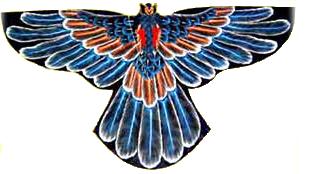 Bali bird
Bali birdA large proportion of all these smaller kites are made to closely resemble various creatures, such as:
- birds
- fish
- butterflies—see that photo!
- frogs
- lizards or "dragons"
The artwork is typically very bold and vivid. It's sometimes almost photographically realistic too! An example would be pink parrot-feathers, painstakingly recreated with fine brushes.
These smaller Balinese kites share the following characteristics:
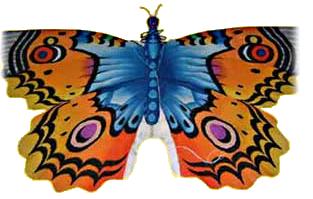 Bali butterfly
Bali butterfly- a small three-dimensional body is attached to a pair of wing-like sails
- leading-edge spars are usually straight or only slightly curved
- trailing edges are much more curved, sometimes with a scalloped outline as well
- a taut covering of nylon (or sometimes rayon) is applied over the frame
- painting is done on the 3D body and the sails to complete the illusion of a real creature—for example, legs painted on the underside of the sail
- long ribbon tails are common, designed to harmonize with the rest of the design
Thanks to the people who supplied the pictures of the bird and
butterfly kites! Your website might be gone, but you know who you are.
In 2019 I was with a bunch of other kite-club members, reorganizing our storage facility. Sitting among all the "big stuff" was a yellow Bali kite—an eagle. It didn't really belong with the other gear, so it was agreed that I could lay claim to it.
Although we went flying later that day, the breeze was rather too light for practically anything to stay up. However, a couple of weeks later, an opportunity came up to see what the bird kite could do. The field was large, and eventually a smooth southerly kept the eagle kite aloft on 120 meters (400 feet) of 20-pound Dacron line.
The vibrant yellow bird turned out to be a typical tourist kite. That is, it looked great in the air, but its performance was very modest! The kite flew nice and stable but rarely made it above 35 degrees from horizontal despite some tweaks to the bridling.
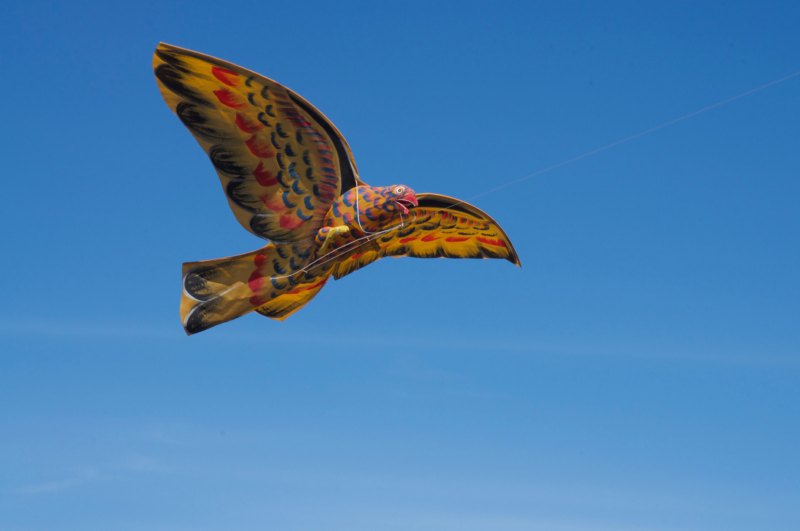 My Bali eagle sags forward for a moment
My Bali eagle sags forward for a moment
The big traditional designs are constructed from wooden or bamboo spars and cotton-cloth sails. Stylized forms of various sea creatures are common, like that Bebean in the top-of-page photo. A uniquely Asian feature of these huge Balinese kites is the hummer. Some traditional Chinese and Japanese kites have these too. Line is stretched between the ends of a bowed pole, creating an instrument that vibrates in the airflow. When two or more of these are used, they are tuned to harmonize. Hence these kites are interesting to listen to, as well as watch, in the air. Imagine the effect with several Balinese kites up there as the blustery trade winds sweep across the island!
Finally, there is the multitude of children's kites. For the most part, these are just simplified variations on the smaller artistic ones described previously. You might see butterfly kites or basic delta-style creations.
It's worth mentioning that the almost fanatical fascination with kites on Bali has resulted in some extremely creative efforts, which have no connection with tradition at all. In a sense, they can't really be called "Balinese kites." They are just the product of talented and keen local kiters—people with an eye for design and a knack for coming up with the unusual. Similar people exist in Germany and the USA!
The Bali Kite Festival
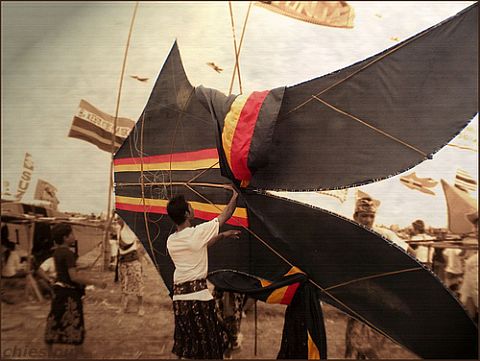 Photo courtesy of Chie
Photo courtesy of ChieThis huge international event is held in July, so no surprises there! That's when the wind—and hence kite flying fever—is at a peak all across the island. So much so, that there are actually problems from time to time. Large runaway kites can plop down in the middle of traffic, causing accidents. Pedestrians and motorbike riders can have nasty encounters with abrasive line draped here and there. Yes, just like in India, there are some keen kite fighters in Bali who insist on using the traditional technique of covering their lines with finely ground glass!
The festival is a real showcase for the largest traditional Balinese kites.
These creations are decorated in simple patterns of black, red, white, and gold/yellow, representing the incarnations of various Hindu gods. There is even a god of kites in Balinese Hinduism! Around a couple of months of careful construction and testing go into each kite, based in a local temple.
International visitors are wowed and intrigued with not only the kites themselves, but also the music and rituals that go with it. A gamelan orchestra strikes up as the majestic kites take to the sky, and entire teams are themselves a spectacle in national dress. Hummers hum and spectators cheer—sometimes when a kite comes unexpectedly to the ground!
If you have ever been to a large kite festival, you will have an idea of the sheer variety of kites to be seen. In Bali, this goes double, since the local kites have great variety in size, shape, and color. Add to that the kites brought in by tourists and invited international visitors, and what a mixture results! There's everything from local kid's kites to big expensive Western show kites.
The photo is another example of the giant traditional kites of Bali. In fact, it looks like another Bebean.
As mentioned earlier, there's more kite making on this site than you can poke a stick at. :-)
Want to know the most convenient way of using it all?
The Big MBK E-book Bundle is a collection of downloads—printable PDF files that provide step-by-step instructions for many kites large and small.
That's every kite in every MBK series.
